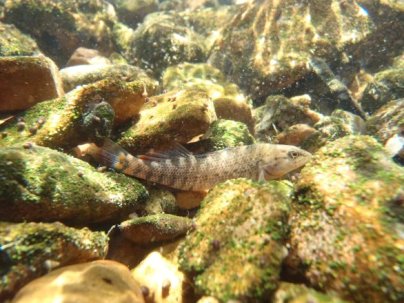Reproduction
The rainbow darter, or Etheostoma caeruleum, has a very unique
reproduction method. For every one female, up to five males may
choose to compete for rights to reproduce with her, and often
times there is a correlation between sperm competition and sperm
production in these male fish. This means that essentially, when
competition is high, there is a reduction in sperm produced,
simply because the male species can wait for another opportunity
to come along, in which case an increase of sperm production
would occur (Fuller, 1998).
During
breeding season, male rainbow darters reside and swim in
riffles, a stretch of rocky shoals or sandbars lying just below
the surface of a waterway with rapidly moving currents. They
wait here for the females (who inhabit the quiet waters
underneath the riffles) to swim up towards the male-occupied
areas of the water. Once this occurs, the male fish rapidly
chase after the swimming female, fighting each other for their
partner. Once this process is completed, reproduction can occur
(Fuller, 1998).

The
Etheostoma caeruleum female has two techniques in order to
complete her part in the spawning cycle: incomplete and complete
nosedigs. In incomplete, the fish burrows her nose into the
gravel on the water's floor and positions her body vertically.
Once this is achieved, she quivers her body. However, after only
this, it is impossible for the male rainbow darter to spawn with
the female. In order for reproduction to occur, a complete
nosedig must be performed by the female fish. This is done by
again, digging the nose into the gravel and vertically
quivering, eventually placing the ventral portion of the body
into the sediment. With the female fish essentially buried, the
male darter can mount and vibrate against the fish. This is when
both the eggs and sperm are released (Fuller, 1998).
It is
possible, and probably likely, for problems to arise during this
process. Often times, other male competitors continually try to
interfere with reproduction. Some male darters attempt to sneak
around the male and female while the spawning is in process and
release their own sperm into the surrounding water. Because of
this continual annoyance of intruders, the male in the process
of reproducing frequently leaves to ward off other competitors,
sometimes leaving the female buried in the gravel floor (Fuller,
1998).
Overall
though, the reproduction process of the Etheostoma caeruleum is
a successful procedure. Once the rainbow darter is inseminated
and the eggs are developed, new fish can be introduced into the
population. After this point, no parental care occurs and the
rainbow darters grow up on their own, eventually repeating this
same process over again (Fuller, 1998).
There are many studies that exist which analyze various
impacts on the reproduction process of the rainbow darter. In Ontario,
Canada at the Grand River watershed, biologists studied twenty-nine of
these Municipal Wastewater Effluent (MMWE) discharges, including a
mixture of both domestic and industrial wastes. They were looking for
alterations in numerous species of fish and how they were affected by
these waters. They found that the fish downstream were bigger in both
size and length, regardless of sex. Additionally, the male darters that
were exposed to the sewage had a greater difficultly producing
testosterone and had decreased cellular development (Bennet
et al., 2011).
Another major
issue that was discovered through this study in Ontario, Canada was the
rates of intersex, or in other words, the abnormal condition of being
intermediate between the male and female sex. As the Etheostoma
caeruleum species were measured farther downstream, the level of
intersex amongst the fish increased. This obviously can create setbacks
in regards to the reproduction of the rainbow darter. The study proved
that the effects of human disposal of sewage wastes may become more
detrimental and pronounced if it is not monitored (Bennet
et al., 2011).
Although the
rainbow darter isn't endangered, there are ways you can help preserve
these fish, including smarter disposal of wastes. Visit
Michigan's Department of Natural Resources to learn more about this
and about the darter in general.
Next, read about interactions among
the Etheostoma caeruleum species and others, or revisit the
home page.